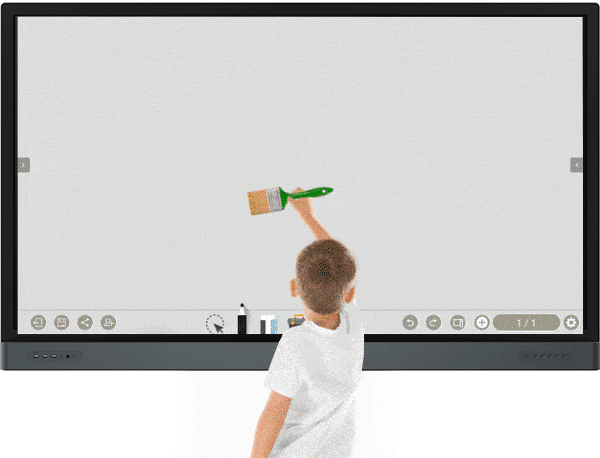An overview of the leading alternatives to aging interactive whiteboards and projectors in classrooms
The interactive whiteboard was one of the first truly transformative education technologies that enabled students to easily engage with a large screen display and a computer.
Not only did early research confirm that there was a statistical increase in learning, but these systems also enabled the use of downloaded pictures and video clips from the Internet, as well as the use of interactive sites such as Google Earth in any classroom.
According to Futuresource, there are nearly 5 million interactive whiteboards in use throughout the world. Yet in just three years, they also predict that interactive whiteboard sales will constitute only 1% of display sales for the classroom.
So if your school is still using an interactive whiteboard from Smart, Promethean, or another manufacturer, what is the best alternative to the technology that has been so successful over the last decade in so many classrooms?


Why Have Schools Stopped Buying Interactive Whiteboards?
A traditional interactive whiteboard uses a projector that displays the image on a special screen equipped with cameras and sensors that enable a teacher or student to control the computer using their fingers or an electromagnetic pen. This enables easy annotation of digital images, and companies like Smart and Promethean have built large libraries of interactive lessons to make it easier for teachers to use the technology.
Despite these advantages, there are some solid reasons schools are looking to make the switch to interactive displays.
Calibrating a whiteboard can be difficult
One problem with a traditional interactive whiteboard is the need to “calibrate” the system so the camera can properly interpret the location of the pen or finger on the screen. This is an essential part of the setup, and if the projector or screen is moved – it may need to be re-calibrated.
For example, some school districts have dedicated web pages to ensure that their teachers can properly go through all the steps to calibrate their system if the system gets bumped – or somehow loses its setting.
Projector lamps are expensive
Most interactive whiteboards sold in North America over the last decade use lamp-powered projectors to fill the screen. Many of these projectors not only have lamps that are expensive to replace – but they also have filters that need to be regularly cleaned. Replacing a lamp after a few years is expensive – and since these lamps contain mercury – may require special handling and disposal.
Interactive Whiteboards are hard to move
If you have read about the benefits of a flipped classroom and would like to use this concept to help your students perform better – a large wall-mounted interactive whiteboard can make this difficult to implement.
Also, because many of these systems have fixed cables in the wall between the computer and projector, moving the system is often impractical. And if you do move it, you will need to recalibrate everything.
The Interactive Whiteboard Alternative – an Interactive Display Designed for Collaboration in Classrooms
In 2020, 93% of schools purchased a purpose-built interactive display (which looks like a big flat TV) instead of an interactive whiteboard. There are several reasons that these have become the new standard in education collaboration.
While the interactive display eliminates the cost of lamps, don’t require calibration, and will enable a flipped classroom – the benefits of the latest education-focused interactive displays are especially valuable in tackling the blended learning challenges faced by teachers and students in a post-pandemic world.
Effortless interactivity with fingers, pens, and even paintbrushes
A modern interactive display can easily track a pen or a finger without extensive calibration. This frees the IT team from having to worry about providing a perfectly flat wall surface to enable an interactive classroom like in the case of interactive whiteboard.
With the latest interactive displays, the sensors are precisely tuned to enable the system to even sense the pressure of a paintbrush – enabling both calligraphy, art, or non-Latin characters such as Kanji.


Improved connectivity to student and teacher devices
Instead of just displaying the output from the dedicated teacher computer, an interactive display can wirelessly connect to a wide variety of devices including Chromebooks, tablets, and smartphones.
The best systems enable a teacher to display multiple sources on the screen at the same time – creating a reliable platform for split-screen teaching.
Remote learning & coaching
With the Coronavirus shutting down schools all over the world, teachers need the ability to effectively engage students when they are not in the classroom. An interactive display enables a teacher to easily broadcast their lessons using downloadable video-conferencing apps that are loaded directly onto the board.
Also, some interactive displays have the ability for students and teachers to collaborate over the cloud – enabling remote coaching for students needing additional help. Imagine a small group session where each student can write on the display right from their device even when they are not on the school network. Now teachers and students can connect from anywhere – at any time – when they need help.


Safer classrooms
An interactive display can be significantly safer than a traditional projector-powered interactive whiteboard. First – you don’t have to worry about the risk of looking directly at a projector with an interactive display, and the best models will automatically reduce the amount of potentially harmful blue light coming from the display.
The most outstanding of these safety features is the use of ![]() anti-microbial coatings on the glass to minimize the spread of germs among students and teachers. These coatings are used in hospitals for objects like nursing carts – and retard the growth of a variety of pathogens on the surface. Models with this technology should be certified by third-party agencies to ensure effectiveness.
anti-microbial coatings on the glass to minimize the spread of germs among students and teachers. These coatings are used in hospitals for objects like nursing carts – and retard the growth of a variety of pathogens on the surface. Models with this technology should be certified by third-party agencies to ensure effectiveness.
Higher resolution
As recently as 2019, over 90% of projectors sold to schools displayed less than 1 million pixels on the screen – while over 90% of televisions sold that year were using the latest 4K technology.
The latest interactive displays enable text to be easier to read by displaying over 8.3 million pixels on the screen. Now our children can have the same high-resolution images at school that they have on their smartphones, tablets, and televisions at home.
Comparison Between Interactive Whiteboard (IWB) and Interactive Displays


Is It Time for Your School to Switch to an Interactive Display?
Cost is always a major consideration when adopting a new piece of equipment, especially technology-focused devices such as interactive displays since the initial investment can be high. But taking into consideration maintenance costs, safety benefits, the ability to adapt to flipped classrooms, and the challenges of hybrid learning, an interactive display is a better investment than more traditional interactive whiteboards.
IT managers will also appreciate the more advanced features such as centralized management software and NFC cards that enable a teacher to use any interactive display on campus – without their computer. In all – these new devices build on the academic success of the interactive whiteboard – while delivering a new and more flexible technology platform for the future.

